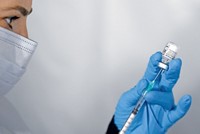Advertisement
Grab your lab coat. Let's get started
Welcome!
Welcome!
Create an account below to get 6 C&EN articles per month, receive newsletters and more - all free.
It seems this is your first time logging in online. Please enter the following information to continue.
As an ACS member you automatically get access to this site. All we need is few more details to create your reading experience.
Not you? Sign in with a different account.
Not you? Sign in with a different account.
ERROR 1
ERROR 1
ERROR 2
ERROR 2
ERROR 2
ERROR 2
ERROR 2
Password and Confirm password must match.
If you have an ACS member number, please enter it here so we can link this account to your membership. (optional)
ERROR 2
ACS values your privacy. By submitting your information, you are gaining access to C&EN and subscribing to our weekly newsletter. We use the information you provide to make your reading experience better, and we will never sell your data to third party members.
Drug Discovery
Laronde raises $440 million for its circular eRNA therapies
The money comes just months after the start-up’s launch
by Ryan Cross
August 30, 2021

Flagship Pioneering is a life sciences–focused investment firm that prides itself on brainstorming dozens of high-risk, high-reward ideas for biotech companies in-house. Many of the ideas never see the light of day. The most promising ones are nurtured into bona fide start-ups, often backed with tens of millions of dollars. Flagship’s most famous creation is Moderna.
Only a few years ago, Moderna and its unproven mRNA technology were the subject of intense skepticism in the biotech industry. Today, the firm is valued at more than $150 billion, thanks to its successful mRNA vaccine for COVID-19 and enthusiasm for experimental mRNA programs for infectious diseases, cancer, and more. But for the scientist-investors at Flagship, Moderna was only the beginning.
In 2017, before Moderna’s blockbuster status was cemented, Flagship quietly began working on a sequel. The new start-up, named Laronde from the French word for “round,” would develop therapies based on circular mRNA.
Most mRNA molecules are linear. But Flagship’s Avak Kahvejian was noticing a trend of scientific papers describing the discovery of mysterious circular RNAs in humans and animals. In work that is still unpublished, Laronde found that the circular shape could make mRNA therapies safer and longer-lasting, and thus more effective.
In May, Flagship debuted Laronde with $50 million in series A financing to develop its circular mRNA therapies, which it dubs endless RNA, or eRNA for short. Laronde began talking to additional investors in June. Just 3 months later, the firm has raised a whopping $440 million series B financing, putting it on a trajectory for rapid growth. “95% of the investors we talked to invested in the company,” Laronde CEO Diego Miralles says. “The universality of support was overwhelming.”
Another start-up, Orna Therapeutics, launched with $80 million back in February to develop circular mRNA therapies based on the work of scientists at the Massachusetts Institute of Technology. Orna calls its therapies “oRNA”—where the “o” represents a circle.
Moderna was founded in 2010 on the premise that mRNA could be used to deliver into cells the genetic code for any protein—including a therapeutic protein for treating rare diseases or cancer or a viral protein as a vaccine. Although the idea was simple in theory, there was no guarantee that it would work in people. Finding the right formulation to safely and effectively deliver the mRNA into human cells was one challenge. Manufacturing enough of the molecule was another.
The pandemic changed that by providing mRNA companies such as Moderna and BioNTech an opportunity to show what mRNA technology could do and by forcing the companies to figure out how to manufacture billions of doses of their mRNA vaccines. “We are standing on the shoulders of giants,” Miralles says. “The risks that mRNA companies took on 10 years ago are not there any more.”
Yet Miralles still sees room for improvement. The firm says its unpublished research demonstrates that circular eRNA is more stable than linear mRNA, partly because there are no dangling ends for mRNA-chopping enzymes called exonucleases to munch on. The circular shape may also help shield eRNA from our bodies’ innate immune system sensors, which have evolved to detect free-floating linear mRNA as a sign of a viral infection. Avoiding that immune response will be important for eRNA therapies that are administered repeatedly for chronic conditions.
Miralles claims that designing and testing Laronde’s eRNA therapies will be extremely fast compared to normal drug discovery programs, which can take years. The eRNA therapies, much like mRNA therapies and vaccines, are designed on computers using the genetic code for the protein that the firm wants the eRNA to produce. “We literally type our drugs,” he says. Every month, Laronde’s two manufacturing suites can synthesize 1,000 different eRNAs, which the company can evaluate in laboratory studies, including in animals, in just 8 weeks, he adds.
Despite that speed, Laronde isn’t disclosing any lead programs yet because the company is still “assessing options,” Miralles says. He also doesn’t want the firm to become defined by a particular program. “We are going to prioritize the low-hanging fruit from a technical standpoint” and initially focus on programs that will help Laronde prove that its eRNA technology works in humans, Miralles adds.
Programs could include antibodies encoded in eRNA, peptides encoded in eRNA for endocrine diseases, or larger proteins encoded in eRNA for genetic diseases caused by protein deficiencies. “Anything that a protein can do, eRNA can do,” Miralles says. “This is a new class of medicines, just like therapeutic antibodies was 30 years ago. And I think 10 years from now, a lot of medicines of the world are going to be eRNA medicines.”




Join the conversation
Contact the reporter
Submit a Letter to the Editor for publication
Engage with us on Twitter